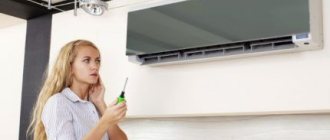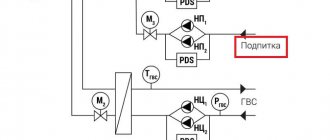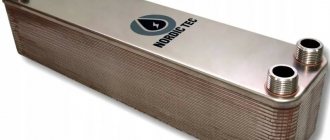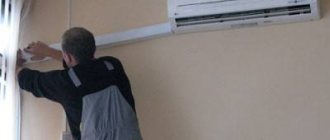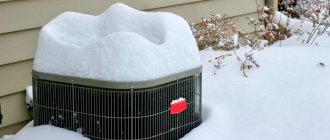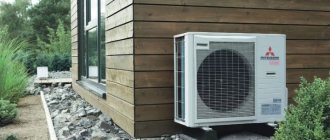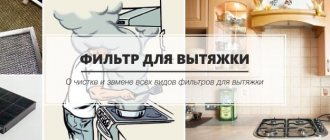Recently I encountered a problem. A new neighbor from the bottom floor approached me with a request to remove the drain from the air conditioner from the street. In response to my surprised remark that everyone does this, she referred to the norms and provisions of the law. And at the end of our conversation, she promised to go to court. I decided to figure out where, according to the rules, the air conditioner drainage should be taken out.
Source odstroy.ru
Requirements for installing an air conditioner drain system
The air conditioner drainage system is designed to remove condensate formed during cooling of the air flow.
This system must have an outlet outside the room where the air conditioner is located. The requirements that the air conditioner drainage system must meet basically repeat the requirements for laying sewer systems:
- The slope of the horizontal sections is about three percent.
- Rotation angles are no more than 45 degrees.
- If drainage is connected to a sewer system, a siphon with a water seal must be installed in front of it. The water standing in it will prevent the penetration of miasma from the sewer into the air conditioning system. When discharging condensate to the street, this requirement does not apply.
Cleaning the indoor unit filters
The filter of the indoor unit is a fine mesh. There is a mesh under the front panel of the air conditioner, through which air is sucked into the device. The filter captures dust from the air, which protects both your home and the air conditioner radiator.
Caring for air conditioner filters includes washing them with warm water. Next, the filter needs to be dried. Removing the filter from the air conditioner and installing it is very simple. Here the instructions for caring for the air conditioner will help you, which describe in detail how to do this.
The filter of the indoor unit must be washed once every 2-3 weeks. However, if there is a lot of “dirt” in the air, washing must be done more often. The main criterion is that the filter must remain clean.
If the air conditioner filter is not maintained, then:
— the air flow to the radiator of the indoor unit of the air conditioner is reduced;
- the air in the room cools much worse;
— the operating mode of the air conditioning refrigeration system may be disrupted. As a result, the copper pipes of the air conditioner may freeze. And when the air conditioner is turned off, the ice will begin to melt and the air conditioner will “drip”;
— possible contamination of the drainage system. If a lot of dust accumulates on the filter, dust clumps will be created. The result is that water from the air conditioner will flow in a stream;
- the further, the more. Over time, a layer of dirt will “grow” on the plastics of the air conditioner radiator, which you will no longer be able to remove yourself; you will need to call a specialist to care for the air conditioner.
Functions of the drainage system
To remove condensate that appears on the evaporator of the indoor unit during gas conversion and cooling, there is a drainage system. In essence, the drainage is a tube in which condensate is removed from the air conditioner. At the same time, the system consists of several components: a tray, connecting pipes and a pipeline.
Before installing climate control equipment, you should understand that there are two types of drainage systems:
- Gravitational;
- Forced.
In the first case, moisture accumulates in the tray, then naturally, according to the laws of gravity, flows down the connected tube into the sewer or directly onto the street. This type of drainage is the most common in an air conditioning network.
The artificial system includes the use of a drainage pump. Its use is justified in two cases: if it is necessary to supply moisture upward or the condensate drain pipe is too long and the liquid cannot flow naturally.
Where does unnecessary liquid come from?
The air in the air conditioner is cooled by circulating refrigerant. The element of the flow pattern in which the temperature decreases is called the evaporator.
The device received this name because droplets of moisture, that is, “perspiration,” appear on its body during operation. The resulting liquid is the same condensate that requires removal from the split system unit.
Moisture is released from warm air at the moment of sudden cooling. One operating unit can accumulate up to 15-20 liters of liquid per day
Draining accumulated moisture is important for proper operation of the air conditioner. The climate control unit operates from the electrical network. As you know, water is a good electrical conductor. At high humidity there is a risk of a short circuit in the device circuit. Breakdown of expensive electrical equipment can be prevented by proper condensate drainage.
Diversion options
There are several methods for installing a drainage system for a wall-mounted air conditioner. The easiest one - when installing the air conditioner, you need to make a hole in the wall and run a hose through it from one side to the street. And on the other hand, connect it through the pipe to the tray located under the evaporator of the indoor module. The simplicity of the manipulations performed is considered a significant advantage of this method.
But such drainage also has disadvantages:
- A hose located outside spoils the outside of the building;
- Water will constantly ooze from the hanging end of the hoses, and if it flows down the wall, this can gradually lead to the destruction of the base of the house.
Another option for removing condensate from an air conditioner is to install a drainage pipe into the sewer line. The method itself is good, but it has one big drawback - usually there is no sewer pipe in the room where the indoor unit is installed.
In this case, there are two options:
- bring the sewer pipe into this room, observing the required slope (2 cm per 1 m of pipe);
- install drainage pipes to the nearest sewer pipe outlet, taking into account the same slope.
The second option is the least labor-intensive and aesthetically pleasing, since a small tube can be easily adjusted to the configuration of the room and hidden under the facing profiles. And in general it can be made invisible. To do this, you will need to make grooves in the wall and then seal them with mortar.
https://www.youtube.com/watch?v=https:accounts.google.comServiceLogin
The third option is to use a special pump. In this case, a storage tank with a level sensor is installed anywhere in the drainage line, and you only need to take into account the difference in height between the pump and the storage tank.
Automatic cleaning of climate control equipment
Modern models of split systems are equipped with options designed to make the owner’s life easier. Their work is aimed at carrying out cleaning without interruption in work. In this case, air masses move through the internal systems and heat exchanger at idle speed. Newer models are equipped with ion air purification systems. Activated oxygen ions form complexes with dust particles, transferring charge to them. “Charged” particles are caught by a special trap. Combining the two systems significantly increases the cleaning potential of the air conditioner.
When installing a pollution sensor, the device independently regulates the activity of filtration systems based on air quality. The listed innovations make it easier to care for climate control equipment. But the device will not be able to wash the filters on its own, so you will still have to clean the air conditioner.
Condensate drainage from the air conditioner to the street
Clogging of the drain, which means the appearance of a leak, largely depends on what kind of tube or hose is installed.
Metal-plastic pipe. A common material for condensate drainage due to its smooth internal walls, and it has a low cost. “Metalplastic” is easy to install through walls, it has an aesthetic appearance, the only condition for installation is that it requires a smooth bend when turning. If the pipe breaks, this will be the best place for dirt to accumulate. And also fasteners for such a pipeline must be done as often as possible, otherwise deflection may occur.
Polypropylene tube. Installers are increasingly using this material to install drainage in large rooms. The use of such drainage is especially important when installing cassette or duct type air conditioners. This tube is quite rigid, it has practically no deflections, so it is good for laying long routes.
Special hose. It has a corrugated surface on the outside and an elastic surface on the inside; it is made of synthetic material, which makes it possible to keep its shape when folded. The outer braid protects the hose from mechanical damage, although it is more difficult to pull it through the holes due to the ribbed surface, but for experienced installers this is not a hindrance.
Thin-walled hose. This type of sleeve also has a ribbed external shape, but with sharp bends it is compressed, and it is recommended to lay it in a groove made of hard material to avoid deflections.
Garden hose. Although outwardly it looks strong and massive, when it “turns” at 90 degrees, its passage opening decreases, so it is only suitable for straight sections.
In domestic conditions, without the help of a specialist, you can clean the drainage system only if only the bath pipe is dirty. To do this you need:
- Unfasten the filter located on the air conditioner body and rinse it thoroughly.
- After removing the lower fastenings, disconnect the drainage tube and remove the bath.
- Wash these parts, paying particular attention to the openings.
Experts also recommend using disinfectants during the cleaning procedure, for example, chlorhexidine solution.
For other failures associated with clogged drainage, you need technical equipment; it is better to call a specialist. Do-it-yourself repairs can damage expensive equipment.
READ MORE: The water in the LG washing machine stopped heating
This is the most common method due to its simplicity and low cost. The pipe is directed at a slope of 1 cm to the street through a hole in the wall. This method is included in the standard installation of an air conditioner.
Taking it outside has its downsides:
- Drops may fall on neighbors' windows or on an iron window sill, causing inconvenience. You may be asked to move the hose away, and the neighbors will be right according to the law.
- The drainage system may freeze in winter.
- Also in winter, cold air can enter the room.
To prevent drops from disturbing others, condensate can be drained into a tank or other container. But this method requires regular checking of the filling of the tank: in hot weather there is a lot of liquid and the containers quickly overflow.
Let's consider bringing drainage to the street as the most common and simplest method.
https://www.youtube.com/watch?v=ytcreators
The drainage hose of the required length is connected to the indoor unit of the system using the appropriate size adapter fitting.
The hoses should not be inserted into each other - such an unsealed connection will be unreliable.
The route for laying the hose should avoid sharp bends and turns, since, flowing down the line and encountering an obstacle in its path in the form of a bend, condensate can accumulate here, preventing the uniformity of the process.
Most often, a joint route is organized between the blocks, where, in addition to drainage, other communications are laid.
If the drainage hose is not made of frost-resistant and wear-resistant material and has a small diameter, then it is useful to hide the drainage line in a corrugated pipe in an outdoor area. There is no point in doing this indoors.
Upon completion of the installation of the air conditioner drainage system, or rather the drainage pipe, the communications of the joint route should be secured together with electrical tape in several places, unless a corrugated pipe with a large diameter serves as an insulating winding. Communications should not be connected in advance to the indoor unit of the air conditioning system.
Drainage of an external unit with an outlet to the street is simple: a flexible hose is connected to the drainage hole located at the bottom of the unit, the outlet of which is positioned so that condensation does not fall on neighbors’ windows, facade ledges and other air conditioners.
When the installation of the air conditioner drainage system is completed, all its parts will be connected, the general communication route laid along the external wall of the house should not be forgotten to be wrapped with electrical tape, or to use another insulation method in the form of a corrugated pipe.
The electrical tape must be wound from bottom to top. The same procedure should be applied to copper pipes in exposed areas and electrical wiring to protect them from corrosion. The hole made in the external wall should be securely filled with silicone sealant.
Leave your feedback on the article in the comments - it is important for us to know your opinion!
Thu, 04 June, 08:41
Let's immediately start talking about air conditioners, and not even about the air conditioners themselves, but about: where and how do we discharge condensate? I think it’s no secret that the facades of our buildings are covered with external blocks of split systems, and water pours on the heads of passers-by, and the hotter the heat, the more water pours. If you can’t pour this water on the heads of passers-by, then where should you put it?
Naturally - into the sewer. But sewerage can be domestic and storm (internal drains). And here a lot of problems arise, because... Even experts do not always know where to dump condensate from air conditioners and fan coils. Ignorance of the answer to this question is due, as often happens, to the fact that the design of air conditioning and air cooling systems is carried out by HVAC (heating, ventilation) designers, and the design of sewerage systems is carried out by VK specialists (plumbing, sewerage) or, in the “newfangled” way, W&W specialists (water supply and sanitation).
“...It is not allowed to drain water from internal drains into the domestic sewer system and connect sanitary fixtures to the system of internal drains...” This requirement is mandatory and has its own explanation - internal drains must be pressure. those. must withstand hydrostatic water pressure.
https://www.youtube.com/watch?v=ytpolicyandsafety
Therefore, SNiP 3.05.01–85 “Internal sanitary fixtures” prescribes regulations for conducting hydraulic tests of internal drains, namely clause 4.15 “... Testing of internal drains should be carried out by filling them with water to the level of the highest drain funnel. The duration of the test must be at least 10 minutes. The drains are considered to have passed the test if no leaks are found during inspection and the water level in the risers has not decreased...”
I think there is no need to explain what will happen when drainage from air conditioners or fan coils is connected to the internal drainage system. In January 2005, the new building of the Moscow State University Library in Moscow was commissioned. Even during the construction stage in the summer, when interior finishing work was carried out, rainwater flooded the premises on all floors where air conditioners were installed.
Ignorance by installers of SNiP or neglect to fulfill their requirements is found everywhere. Now this is even more relevant, because... Licensing of construction work has been cancelled. Conclusion - drainage from air conditioners and fan coil units is connected only to the domestic sewage system.
There is no direct indication of HOW in our regulatory documents, but... SNiP 2.04.01–85* contains clause 17.11 “... The sewer network should be provided with a connection with a “stream break” of at least 20 mm from the top of the receiving funnel: technological equipment for the preparation and food processing; equipment and sanitary appliances for washing dishes installed in public and industrial buildings; drainage pipelines of swimming pools..."
· Contaminated sewerage effluent must not be allowed to enter in any way. firstly, into the bowl of a sanitary appliance (sink). which may contain food products that are not subject to heat treatment (vegetables, fruits), or dishes or cutlery, and secondly, the water of the pools in which we bathe;
READ MORE: Self-leveling floor repair of cracks - when is it necessary and how is it carried out
· in no way should contaminated air from sewer pipelines enter the ventilation or air conditioning system of the building!
These SanPiN requirements must be strictly followed!
Example 1: the ingress of fecal wastewater from leaky external sewer networks into the centralized water supply system of buildings (also leaky, due to the use of steel pipes that are not at all resistant to corrosion), called secondary pollution, leads to outbreaks of hepatitis A diseases!
Example 2: On July 27, 1976, in Philadelphia, at an American Legion veterans' conference, a mysterious illness suddenly struck 221 participants (34 of them died) - this case caused real panic in the United States, and the cause of the disease was identified only on January 18, 1977, when it was discovered earlier an unknown bacterium “Legionella pneumophila” - as it turned out, this bacterium was multiplying in the central air conditioning system installed in the building where the conference was held.
How to clean the device yourself
Many owners of this type of equipment often have a question: how to clean the air conditioner yourself? Of course, this is possible, but it will require patience and these tools:
- a reservoir in the form of some kind of container (it could be a simple tin can);
- rags;
- regular vacuum cleaner;
- filter (new if using disposable ones);
- brush with a long handle;
- special cooling plate;
- oil;
- screwdrivers (it’s better if it’s a full set);
- detergent;
- spray device (for detergent).
All these tools will undoubtedly help you clean the air conditioner correctly, without leaving a single particle of dust.
Please note that the brush and cloths must be clean. For rags you should choose cotton fabric, but in no case synthetics - this will destroy the parts of the device
The detergent can be special, or it can be used for cleaning kitchen and bathroom surfaces. A special detergent can be purchased from a suitable store that sells air conditioners. It is unlikely that you will find it in a regular hardware store. Screwdrivers must be dry and clean. And the filters must be of high quality; make sure that they fit exactly in size and have no defects.
Of course, in order to clean your home air conditioner, you need to use a special list of actions. And it looks exactly like this:
First you need to get rid of the filter that is located on the front grille. Most often it is disposable, so just replace it with a new one. If your air conditioner has a reusable filter, then it needs to be cleaned. The best way to clean the air conditioner filter is with powder. To do this, you need to sprinkle it on the surface of the filter and soak it in hot water for a few minutes (15 minutes will be enough). Afterwards, rinse it well with water and that’s it – the filter is clean.
The second step is to remove the front grilles, which are located on the front of the air conditioning unit. They are often secured from below using two spring-loaded clamps. To remove the grilles, simply press them from the bottom at both edges and pull them up. If the grilles do not budge, it means that there are hidden screws somewhere that need to be found and unscrewed with a screwdriver. Next, remove the metal cover of the unit. It is fastened with screws, you need to unscrew them and then it will not be difficult to lift the cover, thereby removing it. Be careful not to touch other parts of the device. Place all the removed screws in a container or jar; it will be more convenient if there are several jars: for external screws and for internal ones. The fourth step is to check the fan motor, find the hole where the oil is poured. Almost every air conditioner has special plugs
They are made of rubber, so they must be removed with great care, as the plugs may be damaged: cracked or broken. A simple sewing needle or small screwdriver is suitable for removing them.
Try not to pour a lot of oil, there should be enough of it in the device, about 3 or 4 drops on one end of the engine housing and the same amount on the other. You need to drip the oil slowly.
The next step is to carefully remove dust and dirt from the cooling plates. The brush mentioned above will do the job perfectly here. Cleaning should be done slowly with up and down movements. Remember that these plates are very soft and can be easily damaged. After cleaning with a brush, the plates should be treated with a detergent from a spray bottle. The applied product should last about 15 minutes, then it should be washed off with warm water. Make sure that water does not get on other parts of the device. If you notice that the plates are slightly bent, they need to be straightened using a special brush. Now you need to clean the coil itself. To do this, repeat steps numbered 5 and 6. Please note that the plates may be covered with a special plastic casing; if this is the case on your air conditioner, then the casing should be lifted slightly. Now you need to wipe the fan plates. A simple soft cloth is perfect for this. Make sure that the plates do not bend, this can have a detrimental effect on the engine. Use a vacuum cleaner to clean all existing surfaces. And you also need to remember to vacuum under the lid of the device. The base should also be thoroughly cleaned of debris. The remaining water in the base should be drained and the base should be allowed to dry.
After all the work has been done, you need to turn on the air conditioner and check its operation. If no failures are found, then everything was done correctly. As you can see, cleaning the indoor unit of an air conditioner is not so easy, which is why you should be patient.
Installation of air conditioner drainage system
The algorithm for installing drainage to remove condensate from the air conditioner is as follows:
- It is necessary to free the body of the indoor unit from the fasteners so that it can be lifted.
- Below the evaporator there is a tray for collecting condensate. And on the side there is a fitting, to which you need to attach the drainage tube, not forgetting to tighten it with a clamp.
- Install the module housing in place, and it is important to ensure that the hose passes through a special hole in the side wall of the air conditioner.
- Restore fasteners.
All that remains is to lay the hose and take it out into the street or into the sewer. If the installation of the drainage route involves laying it in grooves, then they should be prepared in advance with a certain slope.
Wire cleaning
Another way to clean the drainage hole in the refrigerator is to completely defrost the refrigerator and dry it for 7-10 hours.
Next, you need to use a thin wire to remove the blockage in the tube, being careful not to damage the tube under any circumstances. Cleaning the drainage must be done on both sides at once, after which the hole is washed with warm water.
Important: the wire should not have sharp ends, so before work its edges should be lightly sanded with fine-grain sandpaper. In refrigerators with the No Frost system, the cleaning brush can be located directly in the drainage hole, so the tube can be cleaned without the use of additional products
In refrigerators with the No Frost system, the cleaning brush can be located directly in the drainage hole, so the tube can be cleaned without the use of additional products.
Basic faults
The most common problem with the condensate drainage system is a clogged hole at the tray nozzle. This happens because foreign particles along with dust gradually accumulate on the surface of the bath, and then they block the hole. And as a result, the liquid flows over the top of the tray, drips onto the floor and flows along the walls.
And also when removing condensate from the system, the air conditioner may have other malfunctions:
- channel freezing. During winter operation, if the drainage tube is not insulated, it becomes covered with ice;
- the angle of inclination is not maintained;
- breakdown of the drainage pump;
- the volume of freon has decreased. The most serious failure. This leads to freezing of the heat exchanger and the entire pipeline; as a result of melting, droplets are formed throughout the entire circuit. If measures are not taken in time, this malfunction can lead to compressor failure;
- freezing of the evaporator in the air conditioner. This phenomenon can occur if the outside temperature is sub-zero and, as a result, the refrigerant pressure in the system has decreased due to freezing of the throttle. As in the previous case, the drainage pipe also gradually freezes, melting occurs and condensate leaks throughout the entire section of the pipeline.
It is allowed to clean the condensate drainage system yourself only in a few cases: when the drain hole is clogged with dirt, the outlet hose is frozen and the slope is broken. In other situations, you must immediately turn off the equipment and call a specialist from the service center for
Stages of cleaning the indoor unit
If the climate system has just been purchased, installed and is constantly operating, preventive maintenance is carried out every 30 days. The main measures include washing the fan and filter mesh, as well as cleaning the evaporator, radiator and drainage system.
As noted above, the absence of such work leads to the accumulation of dust, excessive heating and increased noise of the device. Below we will look at how to prevent this.
Cleaning fans and filter screens
A mesh filter is mounted inside, which is easy to remove and inspect. To dismantle, you need to disconnect the equipment from the household network and remove the front cover by unscrewing the fixing screws.
POPULAR WITH READERS: Introducing the rating of electric convectors
Now all that remains is to remove the mesh from the air conditioner, soak it in a soapy solution or a special product, and then leave it for a while.
The next step is to flush the fan that moves cold air. During operation, a thick layer of dust, debris and grease accumulates on the blades of the product.
There are two types of fans: removable and non-removable. In the latter case, cleaning is done using a brush. This is not very convenient, but it allows you to remove excess dirt.
To prevent a removable fan, you need to immerse it in soapy water, hold it in it for some time, then remove it and return it to its place.
If there is an unpleasant odor, it is recommended to do additional work - disinfect the surface of the mesh and fan using a special product. The optimal frequency of the work discussed above is once every four weeks.
Prevention of the radiator and heat exchanger
In most models, the heat exchanger and radiator are mounted in the indoor unit. For high-quality cleaning, it is recommended to dismantle and disassemble the unit, and then begin cleaning work.
This is an expensive process, so you can save on it and do the work yourself.
Here are step-by-step instructions:
- Remove the front cover;
- Remove filters;
- Use a vacuum cleaner to remove dust. It is allowed to use a brush with long bristles. The latter method is considered safer for the evaporator plates (they can be accidentally damaged). When cleaning, it is recommended to move from the top to the bottom;
- Remove dirt films using a steam cleaner;
- Set the air conditioner to recirculation mode and set the lower temperature threshold;
- In the area where the device draws in air, spray an antiseptic using a spray bottle. Be careful not to get the product on the radiator.
To avoid contamination of the heat exchanger plates, it is recommended to act promptly and perform cleaning once every 30 days. It is best to do the work in conjunction with washing the filter.
Cleaning and disinfection of drainage
The air conditioner is equipped with a drainage system consisting of 2 units:
- Tray - designed to collect excess moisture;
- Tube - it is used to drain water.
The accumulation of dust and its interaction with moisture leads to the appearance of mold, fungi and bacteria, and the main result is the appearance of an unpleasant odor when turned on.
Once dust and debris enter the drainage system, these elements become contaminated. After some time, the air conditioner begins to drip.
For prevention, you need to discard the tray from the board and outlet tube, and then remove it and rinse it in water.
Cleaning the drainage system tube is done using a conventional vacuum cleaner or compressor in blowing mode. To flush the channel, use running water, a soap composition or a special cleaning agent.
In severe cases, mold and mildew have already spread throughout the system, so a mold and mildew remover is required to remove the dirt.
Special attention should be paid to the treatment of the pallet, because it is often the main source of stench
Saint Petersburg
INN: 7801190998 Legal address: 191124, St. Petersburg, st. Stavropolskaya, 10, lit. A
Checkpoint: 784201001 Actual address: 191124, St. Petersburg, st. Stavropolskaya, 10, lit. A. (address for receiving correspondence)
Checkpoint: 772143001 Branch of Promoborudovanie-SIS LLC in Moscow 109428, Moscow, Ryazansky Prospekt, 16, building 4
account: 40702810555160162144 to the North-West Bank of OJSC Sberbank of Russia, St. Petersburg
BIC 044030653 c/s: 30101810500000000653
OKPO 56325292 OKONKH 66000, 95130, 14112, 61124 OKVED 51.70, 51.53.21, 51.54.2
General Director Ivanova Tatyana Yurievna
All rights reserved LLC Promoborudovanie-SIS 2001-2016. Any copying of materials from the PROMSIS.SPB.RU website is possible only with the written permission of the company.
Purpose of the product
The operating principle of the air conditioning device is based on absorbing water from the air, which is why condensation occurs. Moisture remains on the cold plates of the heat exchanger, which is then collected in a special container - a drainage pipe. Therefore, it is believed that if water drains from the air conditioner (external tank), then this is its normal operating condition.
The constant dripping of water from the external drain pipe of the air conditioner does not bother many of its owners at all - it’s not dripping in the apartment. However, this situation can have many negative consequences:
- Constant dripping of water, especially when installing an air conditioner in a private house, can harm not only the blind area, but also the foundation of the building.
- When installing an air conditioner in an apartment building, dripping water can cause problems for the residents of the lower floors. Hardly anyone will be happy to listen to the constant knocking of drops on a window sill, balcony, or the wetness of the external wall of the apartment.
- The very sight of an air conditioning device with water dripping from it is not particularly pleasing to the eye.
- There are problems with using an air conditioning device in winter, since the liquid in the drain pipe may freeze and, as a result, break down the air conditioner itself.
In addition, the European Union has already completely banned the installation of air conditioners that allow condensation to enter the external environment. Domestic legislators may soon become concerned with this issue.
Design features
As an example, you can use split systems.
Their outdoor unit includes several main components, including a compressor, control board, valve, fan, radiator, freon system filter, protective cover and fitting connections. With the help of a compressor, freon is compressed and its movement along the refrigeration circuit is maintained. The basis can be a piston or a spiral. Models with a piston have a lower price, but are not reliable enough. This is especially true in the cold season, when there is a drop in temperature outside. A four-way valve is provided in those systems that operate on both cold and heat.
Inverter outdoor units require a control board. In other cases, the electronics system is located internally to prevent damage due to changes in temperature and humidity levels.
The fan serves to cool the condenser in a timely manner. If we are talking about budget models, it will have one rotation speed, but in more expensive ones it depends on what the outside air temperature is. Most often, fans have 2-3 speeds, which are regulated quite smoothly.
As for the radiator, it is due to it that cooling and condensation of freon occurs. The freon filter provides protection from copper chips and other elements that clog the air conditioner during installation and operation. However, if errors were made during the installation process, then a significant amount of dirt can get inside, which even this system cannot cope with.
The protective cover hides the terminal block, and in some cases, the connections on the fittings, to which, in turn, the connectors of both air conditioner units are connected.
Tips and tricks
- It's better to do it right right away than to redo it later. It all depends on the installers who will carry out the installation. The degree of professionalism can be judged by the equipment of the team. If they are dressed in overalls and use personal protective equipment, then we can say with a high degree of confidence that they are professionals and know the intricacies of their work.
- If a problem arises on equipment that has already been put into operation, it makes sense to invite a specialized organization. It’s unlikely that anyone at home has a high-pressure compressor and powerful chemicals, so to speak, “in reserve” - they cost a lot of money and are sold, most often, by the kilogram, with a consumption of 100 grams per cleaning.
- In addition to cleaning the drain, you also need to clean the air filters, impeller, outdoor unit and radiator. For this procedure, cleaning units of the Karcher brand are used. You can do it yourself, but it will take several days for an unprepared person.
Source
What work does maintenance include?
Very often, in the technical data sheet accompanying the cooling device, a separate clause stipulates that the consumer using the air conditioner must carry out its maintenance himself within the limits of his abilities and capabilities. So how to maintain your air conditioner at home?
Affordable home maintenance includes activities such as cleaning or replacing filters located in the indoor unit. For this procedure you do not need to have any special knowledge, just refer to the instructions. The filter of the internal unit of the device is a mesh, which is not difficult to reach. You just need to open the top cover and carefully pull out the filter. You can clean the mesh using any available means. Vacuum or wash. It's your choice. The most important point here is drying. The filter must dry at room temperature, without using any heating devices or direct sunlight.
Maintenance of air conditioners consists of a number of preventive works and procedures that should be performed when the need arises. Here is an approximate list of services that are performed by specialists during regular professional services:
- External inspection of equipment, its units, components and housing for breakdowns and various types of damage;
- Washing the air filter of the indoor unit and cleaning the blinds located at the entrance;
- Cleaning heat exchangers, both external and internal units. Moreover, the heat exchanger located in the indoor unit is processed by a steam generator using various non-aggressive agents and aerosols. And the cleaning of the heat exchanger, which is located in the external block, occurs under high pressure;
- Full check of the operating condition of the power supply system;
- A thorough examination of all butt joints through which freon moves;
- Checking the presence of freon in the device system and its quantity. If necessary, a specialist will refill the refrigerant;
- Checking the operation of the drainage system of the equipment, the patency of the tubes and the condition of other elements;
- Inspecting fan blades for faults and checking electric motors;
- Mandatory testing of the operation of the air conditioner in all provided modes.
Many organizations whose services include repair and maintenance of air conditioners offer various types of service, which differ in time intervals. For example, quarterly or monthly maintenance, preventive inspection twice a year. The choice depends on the intensity of use of the equipment and the location where it is installed. And also on the personal preferences and capabilities of consumers.

